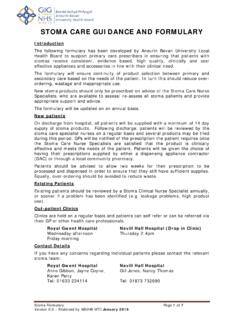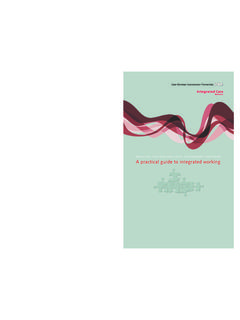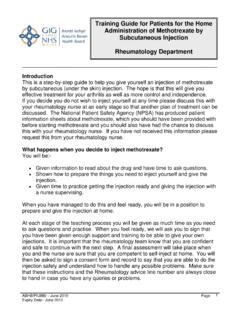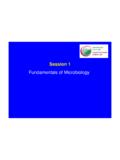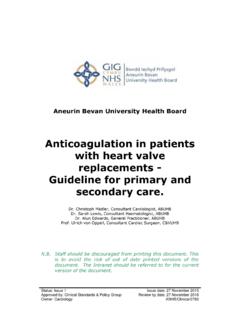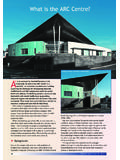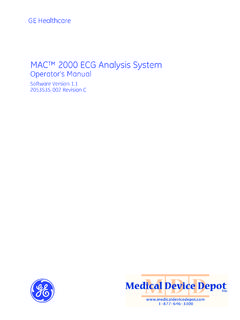Transcription of Preoperative hair removal to reduce surgical site infection
1 Preoperative hair removal to reduce surgical site infection (Review). Tanner J, Woodings D, Moncaster K. This is a reprint of a Cochrane review, prepared and maintained by The Cochrane Collaboration and published in The Cochrane Library 2008, Issue 1. Preoperative hair removal to reduce surgical site infection (Review) 1. Copyright 2008 The Cochrane Collaboration. Published by John Wiley & Sons, Ltd TABLE OF CONTENTS. ABSTRACT .. 1. PLAIN LANGUAGE SUMMARY .. 2. BACKGROUND .. 2. OBJECTIVES .. 3. CRITERIA FOR CONSIDERING STUDIES FOR THIS REVIEW .. 3. SEARCH METHODS FOR IDENTIFICATION OF STUDIES .. 3. METHODS OF THE REVIEW .. 4. DESCRIPTION OF STUDIES .. 5. METHODOLOGICAL QUALITY .. 6. RESULTS .. 7. DISCUSSION .. 8. AUTHORS' CONCLUSIONS .. 9. POTENTIAL CONFLICT OF INTEREST .. 10. ACKNOWLEDGEMENTS .. 10. SOURCES OF SUPPORT .. 10. REFERENCES .. 10. TABLES .. 12. Characteristics of included studies .. 12. Characteristics of excluded studies.
2 15. ANALYSES .. 16. Comparison 01. shaving compared with no hair removal .. 16. Comparison 02. cream compared with no hair removal .. 16. Comparison 03. shaving compared with clipping .. 16. Comparison 04. shaving compared with cream .. 16. Comparison 05. shaving day before compared with shaving day of surgery .. 16. Comparison 06. clipping day before compared with clipping day of surgery .. 16. INDEX TERMS .. 16. COVER SHEET .. 17. GRAPHS AND OTHER TABLES .. 18. Analysis Comparison 01 shaving compared with no hair removal , Outcome 01 wound infection - existence of pus 18. Analysis Comparison 02 cream compared with no hair removal , Outcome 01 wound infection existence of pus 19. Analysis Comparison 03 shaving compared with clipping, Outcome 01 wound infection - existence of pus . 20. Analysis Comparison 04 shaving compared with cream, Outcome 01 wound infection existence of pus .. 21. Analysis Comparison 05 shaving day before compared with shaving day of surgery, Outcome 01 wound infection 22.
3 Day 15 .. Analysis Comparison 05 shaving day before compared with shaving day of surgery, Outcome 02 wound infection 23. day 30 .. Analysis Comparison 06 clipping day before compared with clipping day of surgery, Outcome 01 wound infection 24. day 15 .. Analysis Comparison 06 clipping day before compared with clipping day of surgery, Outcome 02 wound infection 25. day 30 .. Preoperative hair removal to reduce surgical site infection (Review) i Copyright 2008 The Cochrane Collaboration. Published by John Wiley & Sons, Ltd Preoperative hair removal to reduce surgical site infection (Review). Tanner J, Woodings D, Moncaster K. This record should be cited as: Tanner J, Woodings D, Moncaster K. Preoperative hair removal to reduce surgical site infection . Cochrane Database of Systematic Reviews 2006, Issue 3. Art. No.: CD004122. DOI: This version first published online: 19 July 2006 in Issue 3, 2006. Date of most recent substantive amendment: 21 April 2006.
4 ABSTRACT. Background The preparation of people for surgery has traditionally included the routine removal of body hair from the intended surgical wound site. However, there are studies which claim that pre-operative hair removal is deleterious to patients, perhaps by causing surgical site infections (SSIs), and should not be carried out. Objectives The primary objective of this review was to determine if routine pre-operative hair removal results in fewer SSIs than not removing hair. Search strategy The reviewers searched the Cochrane Wounds Group Specialised Register (October 2005), The Cochrane Central Register of Controlled Trials (The Cochrane Library Issue 3, 2005), MEDLINE (1966 to 2005), EMBASE (1980 to 2005), CINAHL (1982 to 2005), and the ZETOC database of conference proceedings (1993 to 2005). We also contacted manufacturers of hair removal products. Selection criteria Randomised controlled trials (RCTs) comparing hair removal with no hair removal , different methods of hair removal , hair removal conducted at different times prior to surgery and hair removal carried out in different settings.
5 Data collection and analysis Three authors independently assessed the relevance and quality of each trial. Data was extracted independently by one author and cross checked for accuracy by a second author. Main results Eleven RCTs were included in this review. Three trials involving 625 people compared hair removal using either depilatory cream or razors with no hair removal and found no statistically significant difference between the groups in terms of surgical site infections. No trials were identified which compared clipping with no hair removal . Three trials involving 3193 people compared shaving with clipping and found that there were statistically significantly more SSIs when people were shaved rather than clipped (RR , 95%CI. to ). Seven trials involving 1213 people compared shaving with removing hair using a depilatory cream and found that there were statistically significantly more SSIs when people were shaved than when a cream was used (RR , 95%CI to ).
6 No trials were found that compared clipping with a depilatory cream. One trial compared shaving on the day of surgery with shaving the day before surgery and one trial compared clipping on the day of surgery with clipping the day before surgery; neither trial found a statistically significant difference in the number of SSIs. No trials were found that compared depilatory cream at different times or that compared hair removal in different settings. Authors' conclusions The evidence finds no difference in SSIs among patients who have had hair removed prior to surgery and those who have not. If it is necessary to remove hair then both clipping and depilatory creams results in fewer SSIs than shaving using a razor. There is no difference in SSIs when patients are shaved or clipped one day before surgery or on the day of surgery. Preoperative hair removal to reduce surgical site infection (Review) 1. Copyright 2008 The Cochrane Collaboration.
7 Published by John Wiley & Sons, Ltd PLAIN LANGUAGE SUMMARY. When people are being prepared for surgery removing body hair from the area of the surgical incision may reduce the chance of the surgical site becoming infected. Traditionally people undergoing surgery have body hair removed from the intended surgical wound site as this is thought to reduce the chance of the surgical site becoming infected. Three methods of hair removal are currently used; shaving with a razor, clipping with clippers and using a cream which dissolves the hair. Removing hair before surgery using a cream results in fewer surgical site infections than shaving. However if it is necessary to remove hair then it is preferable to use clippers rather than shaving with a razor as this results in fewer surgical site infections. BACKGROUND Shaving and clipping can be carried out in operating theatres, anaesthetic rooms, wards or in peoples' homes by theatre staff, The preparation of people for surgery has traditionally included ward staff, or by patients themselves.
8 Chemical depilation is usu- the routine removal of body hair from the intended surgical wound ally carried out on wards or in the home as it requires more time. site. Hair is removed as its presence can interfere with the exposure Research has suggested however that hair removal should not take of the incision and subsequent wound, the suturing of the inci- place in the operating theatre as loose hair may contaminate the sion and the application of adhesive drapes and wound dressings sterile surgical field (Mews 2000). Others have suggested that hair (Hallstrom 1993; Miller 2001). Hair is also perceived to be asso- removal should be carried out by skilled personnel to prevent abra- ciated with a lack of cleanliness and the removal of hair is thought sion injuries (Hallstrom 1993; Small 1996). to reduce the risk of surgical site infections (SSIs) (Kumar 2002). During the process of shaving, the skin may experience micro- However, there are studies which claim that pre-operative hair re- scopic cuts and abrasions.
9 It is believed that microorganisms can moval is deleterious, perhaps by causing SSIs, and should not be enter and colonise these cuts and contaminate the surgical wound carried out (Alexander 1983; Court Brown 1981; Horgan 1997). causing post-operative wound infections (Briggs 1997). In addi- The Center for Disease Control categorises SSIs as being either su- tion abrasions may ooze exudates, which may provide a culture perficial incisional, deep incisional or organ/space, and states that medium for microorganisms (Seropian 1971). Since clippers do the presence of infection should be identified using both clinical not come into contact with the patient's skin they are thought to and laboratory findings and may include the presence of at least reduce the risk of cuts and abrasions (Fogg 1999). one of the following; pus, pain, tenderness, swelling or redness A systematic review of Preoperative shaving was published in 2002.
10 (Mangram 1999). SSIs are experienced by around 10% of patients (Kjonniksen 2002). The search for this review was up until 1999. in the UK each year (NINSS 2001) and can result in delayed and included both randomised and observational studies. Evi- wound healing, increased hospital stays, unnecessary pain and in dence for not removing hair was found in observational studies extreme cases the death of the patient (Emmerson 1996; Plowman only. Strong evidence was found in support of clipping in prefer- 2000). ence to shaving. Observational studies supported depilation rather Three methods of hair removal are currently used; shaving, clip- than shaving. Moderate evidence, based on observational studies ping and chemical depilation. Shaving is the commonest and and a randomised study (though this is not statistically signifi- cheapest method of hair removal . This method uses a sharp blade, cant) finds that the timing of hair removal should be as close to held within the head of a razor, which is drawn over the patient's surgery as possible.
